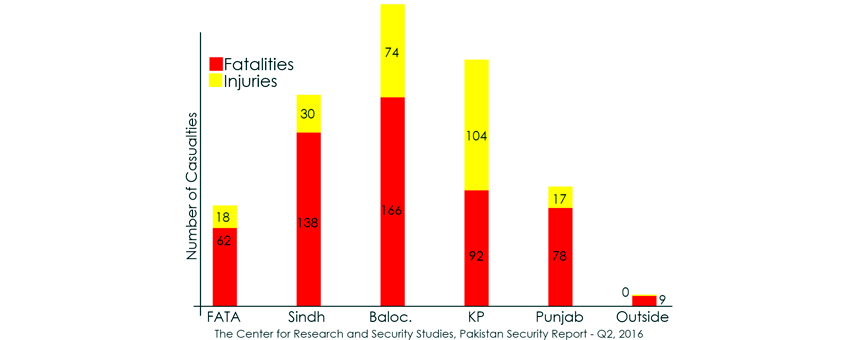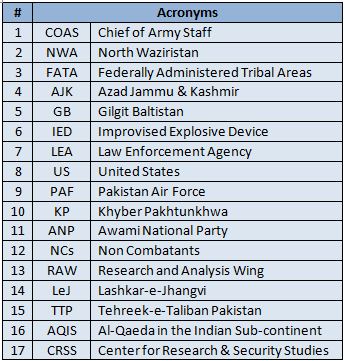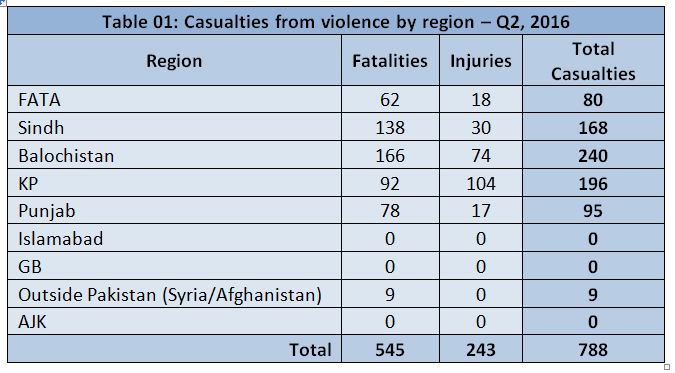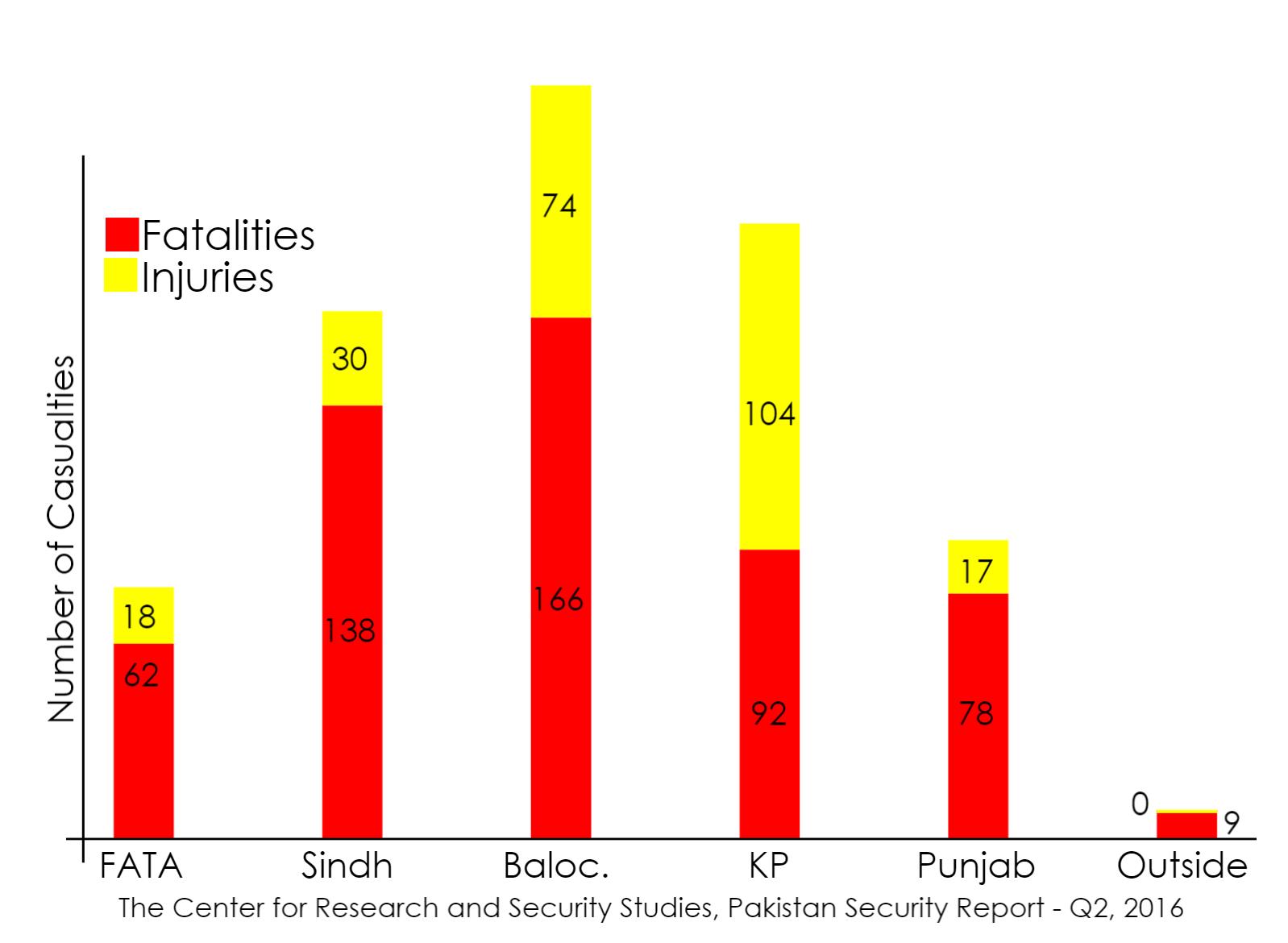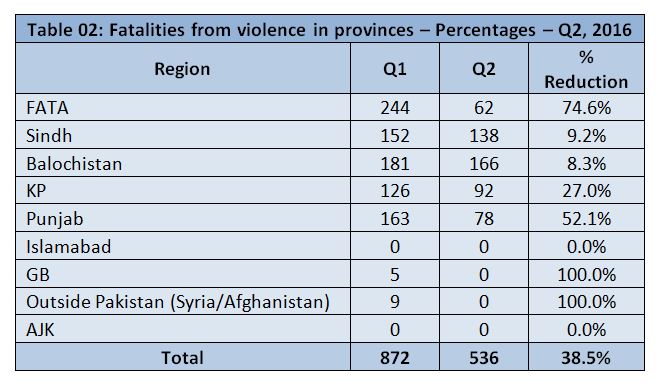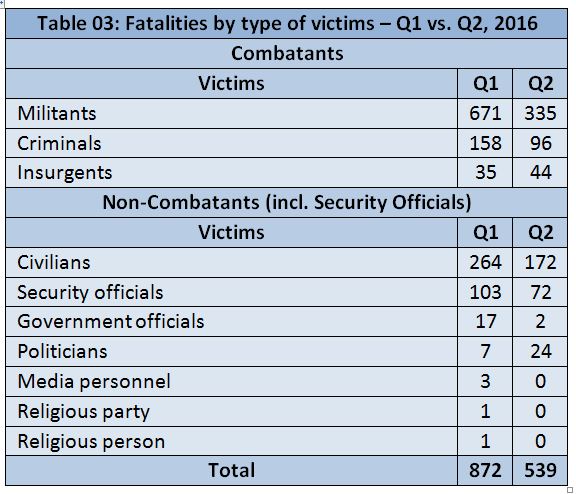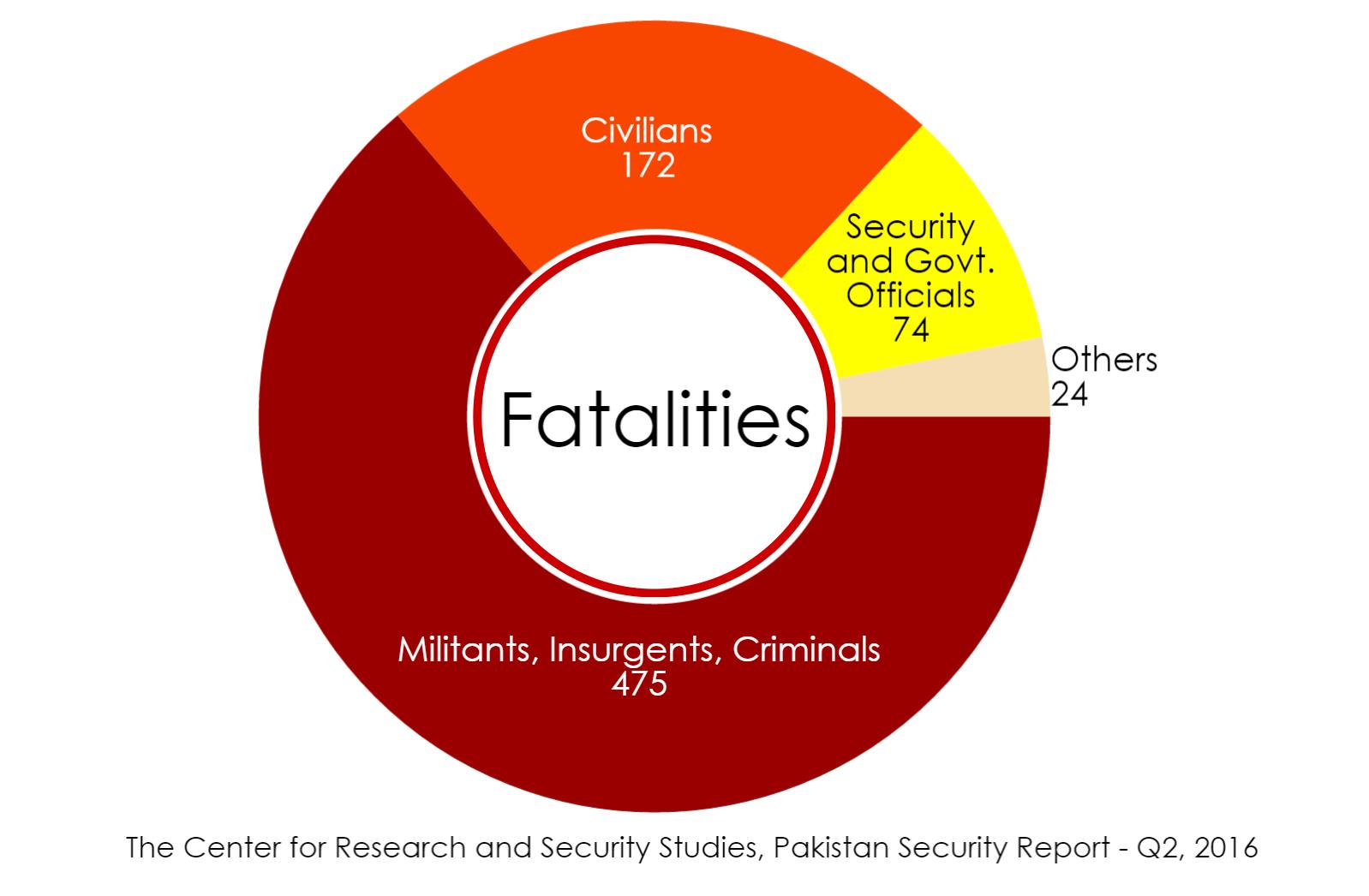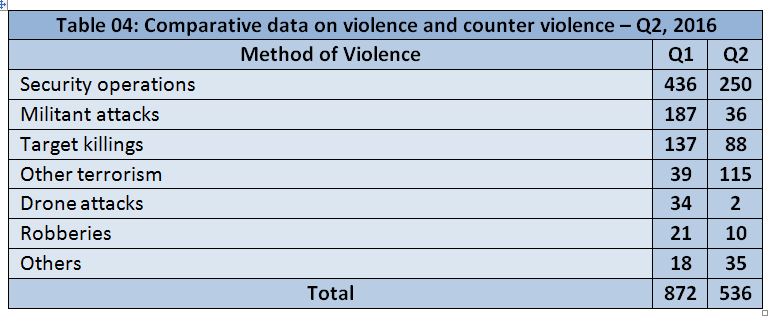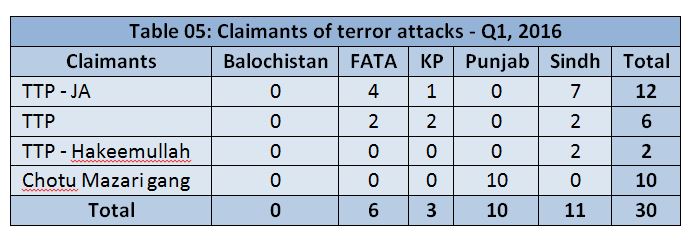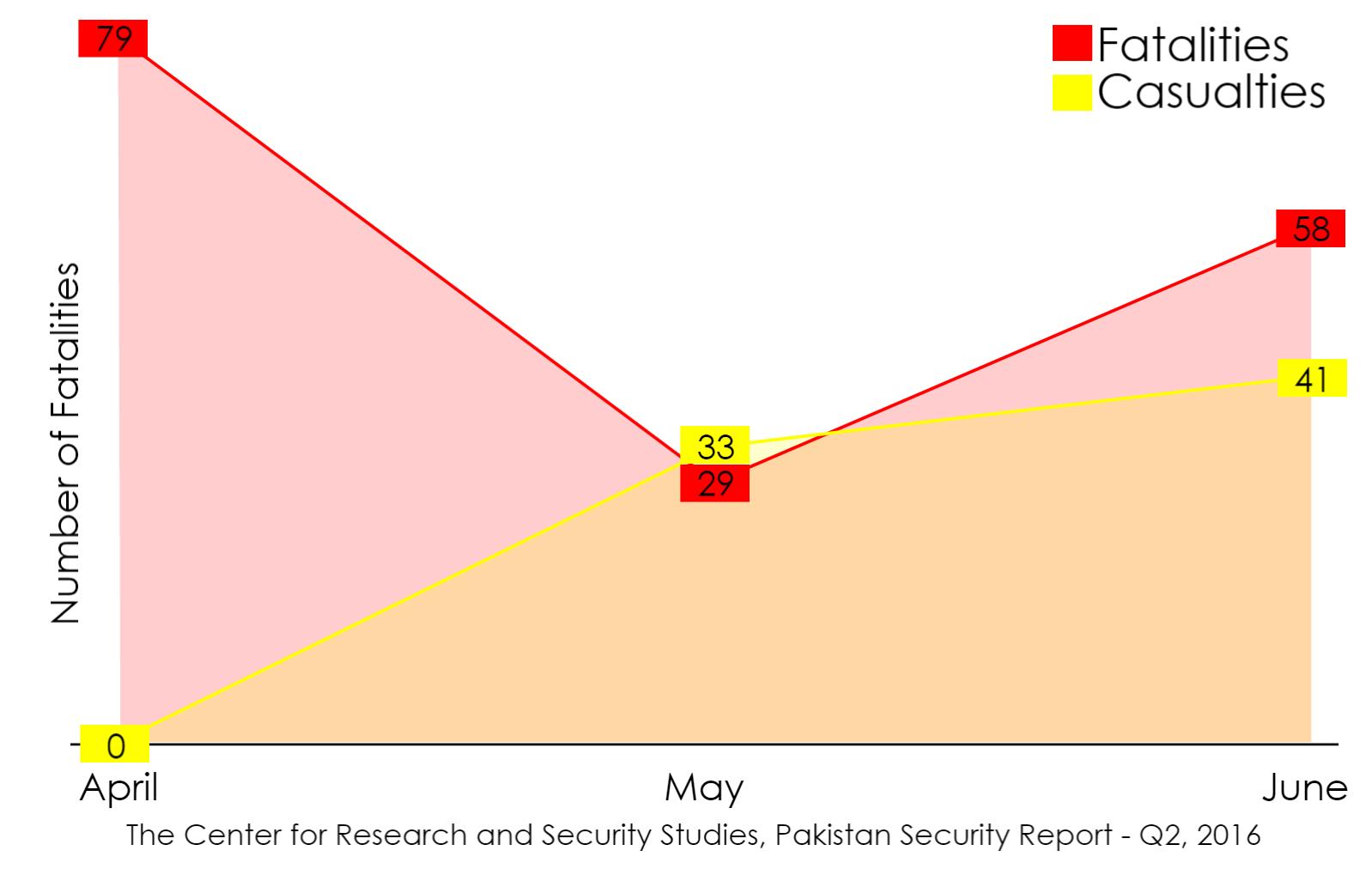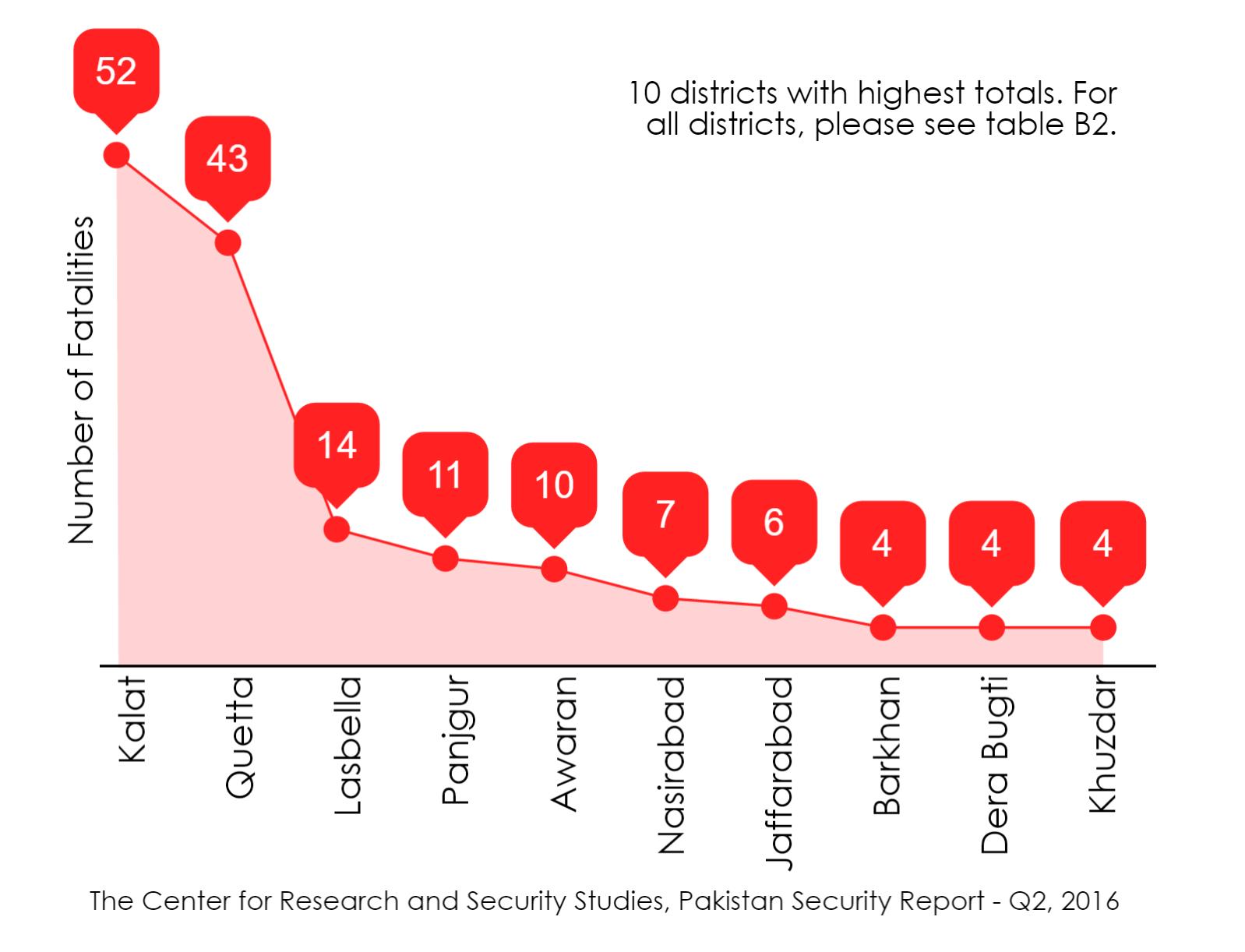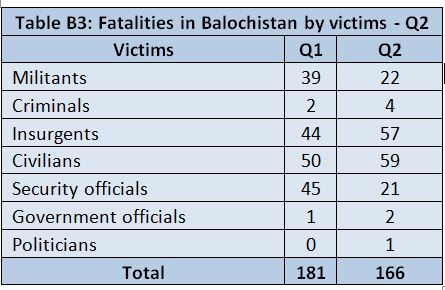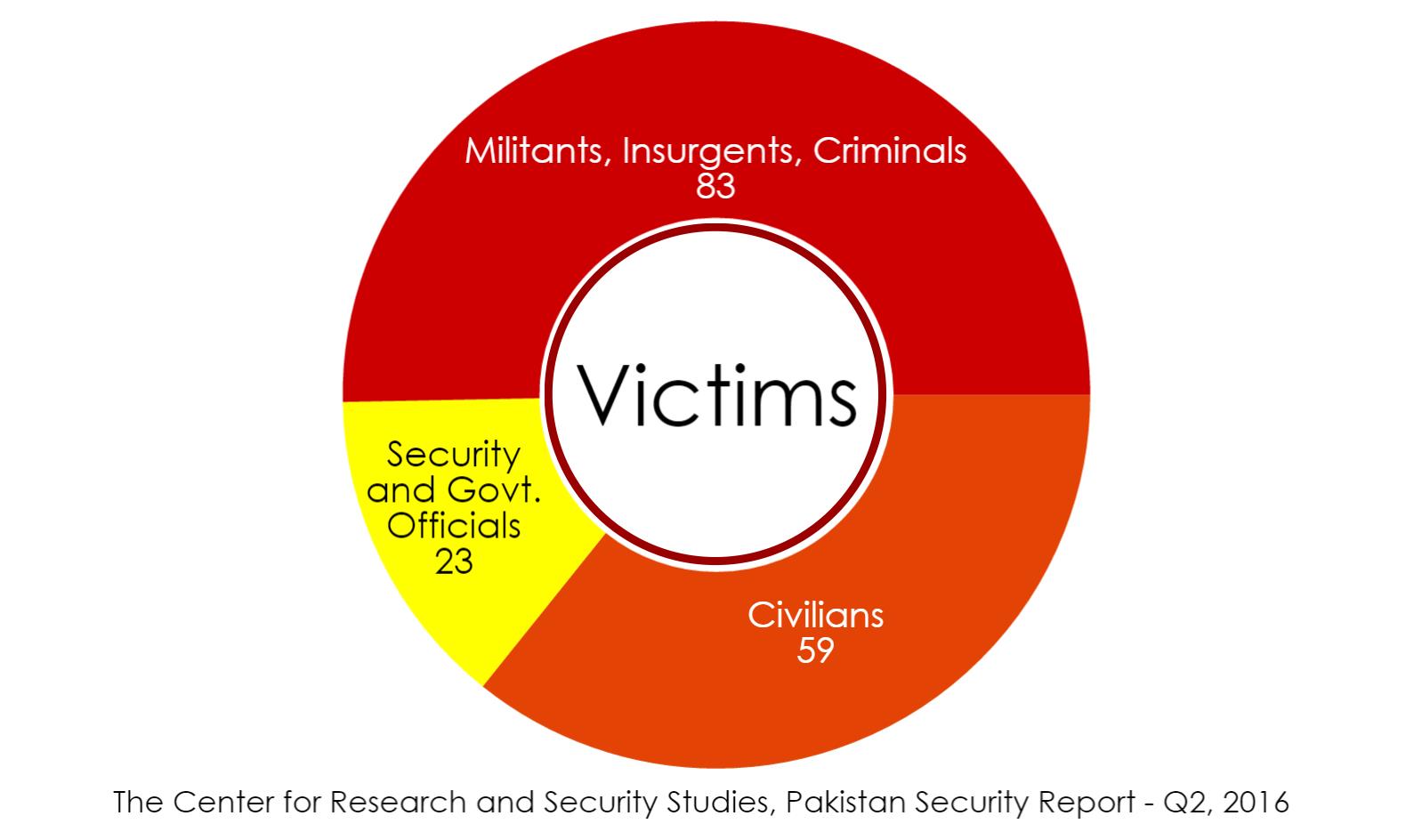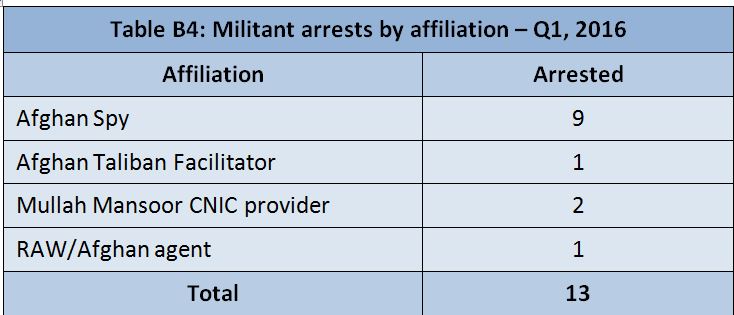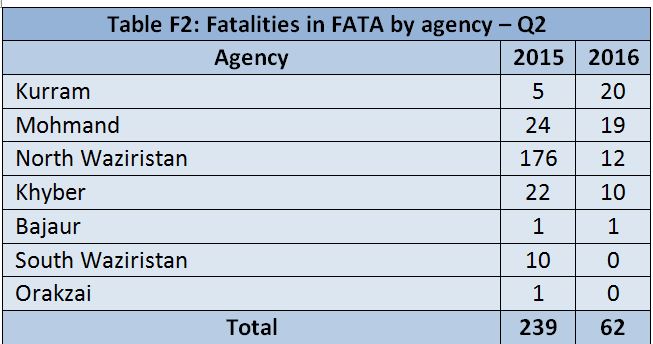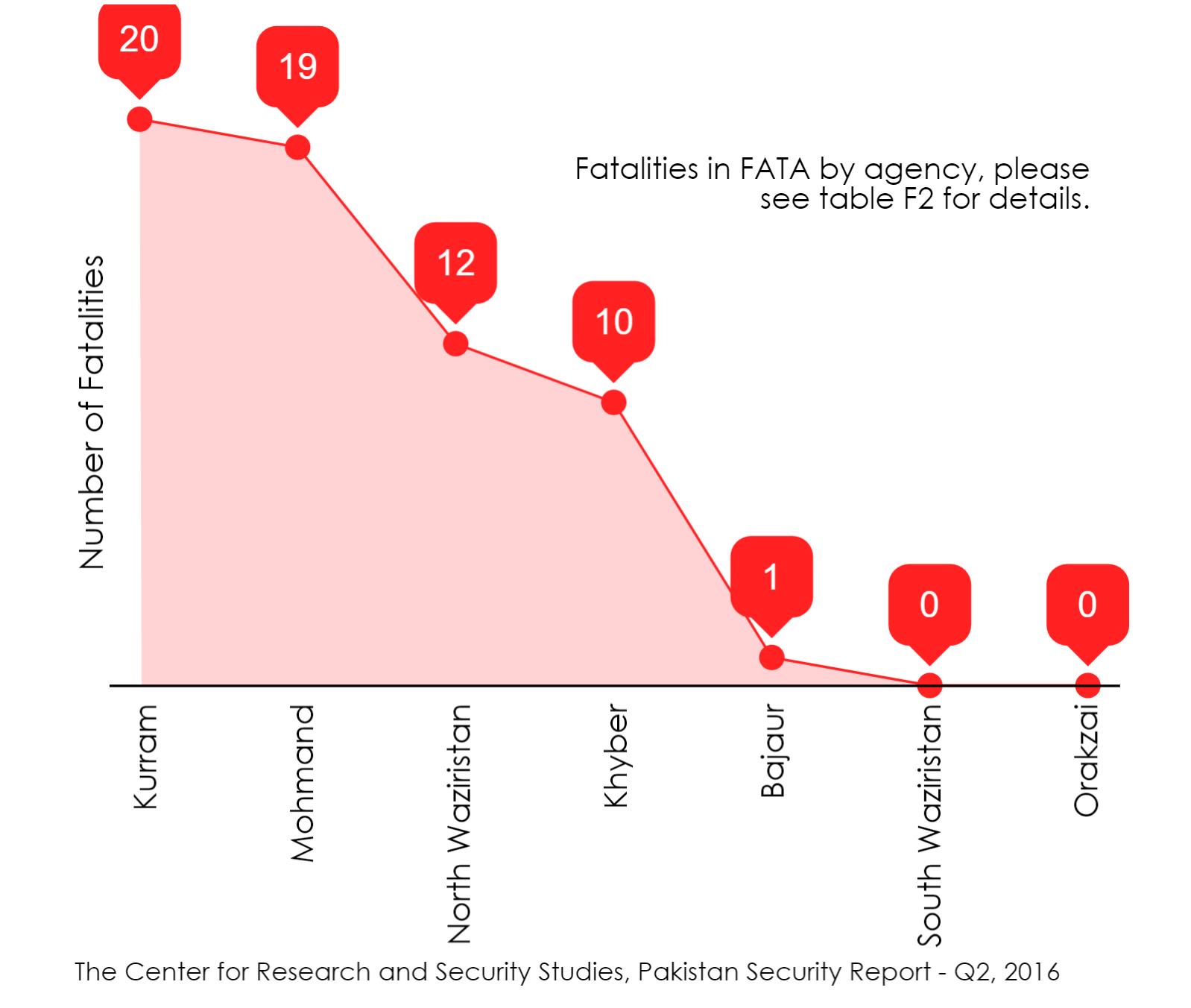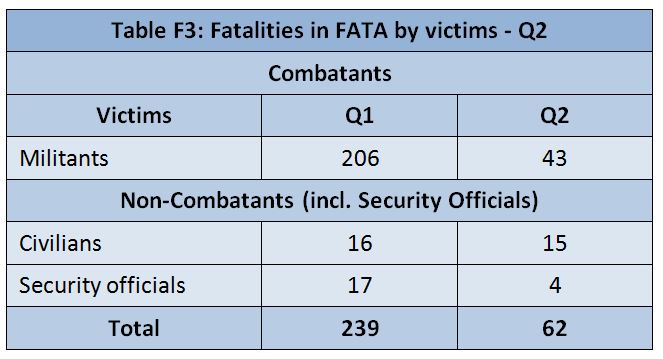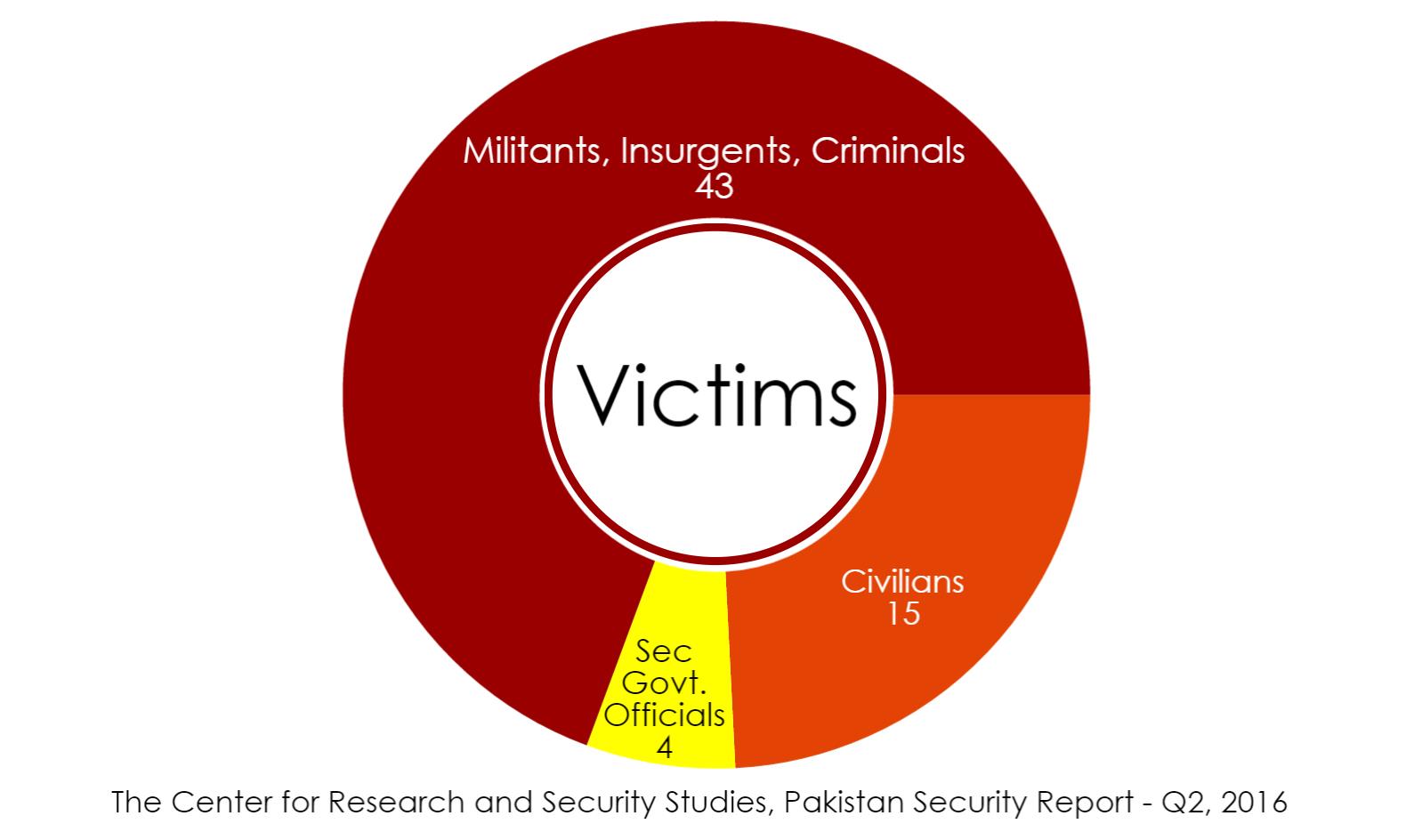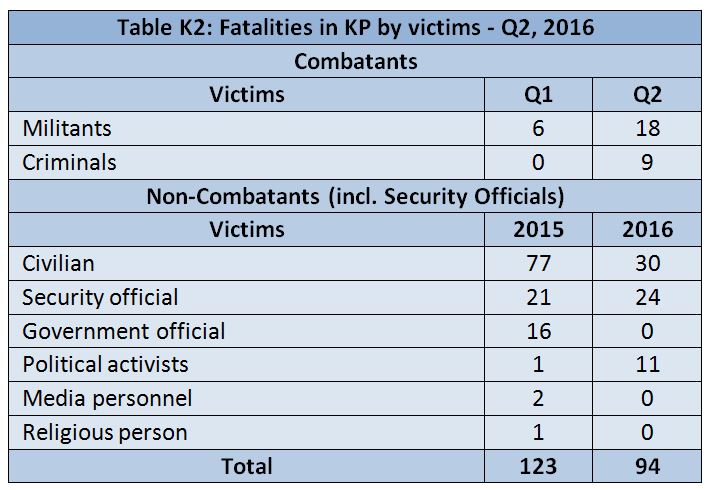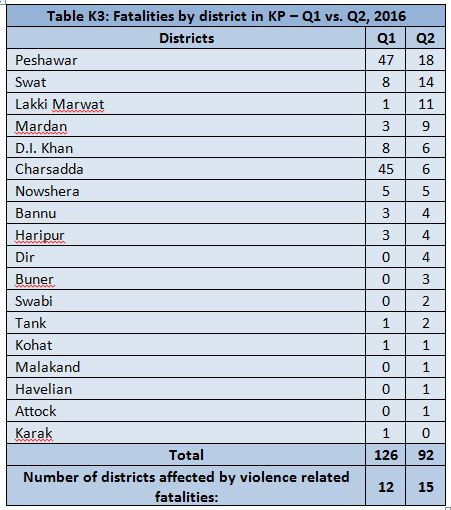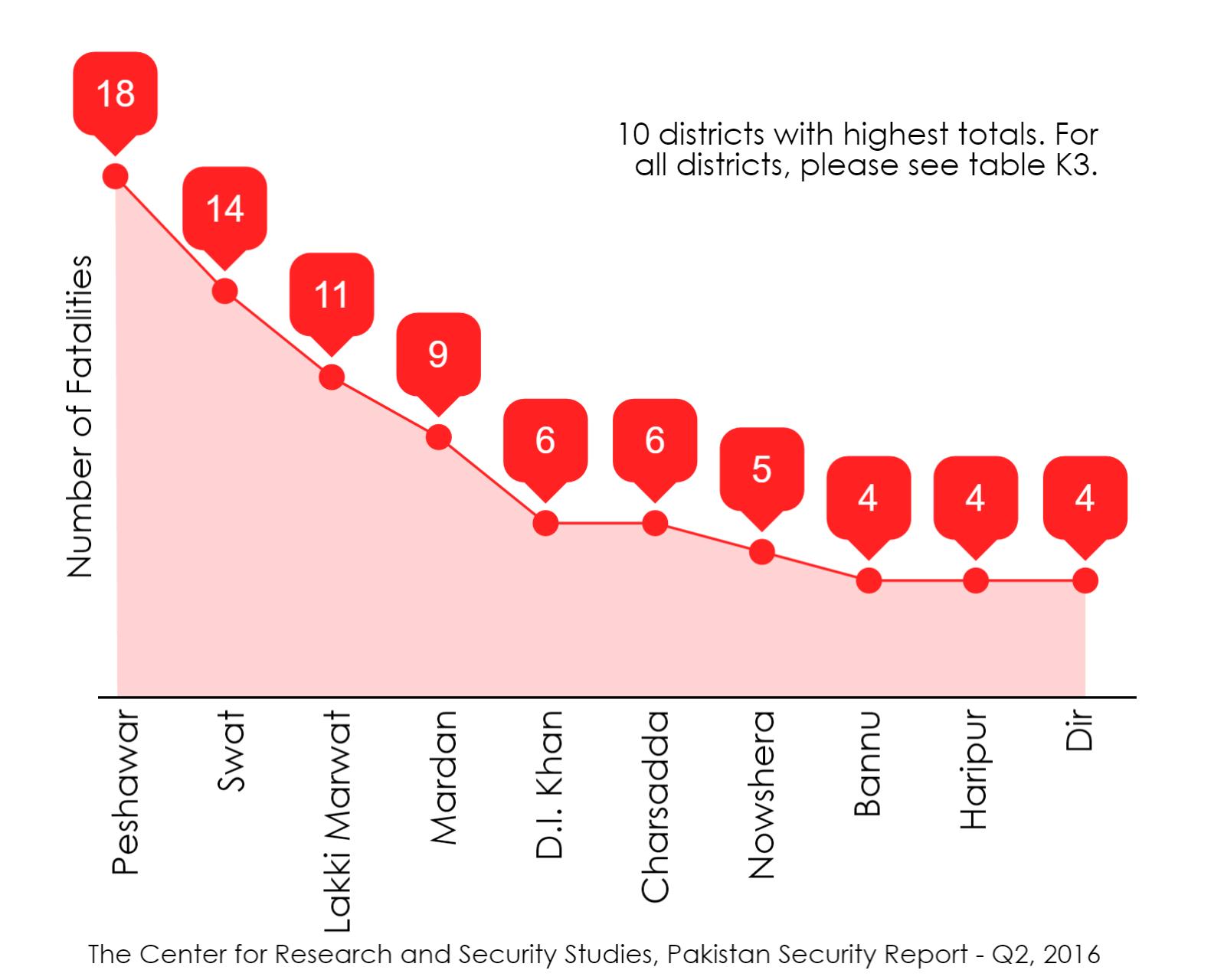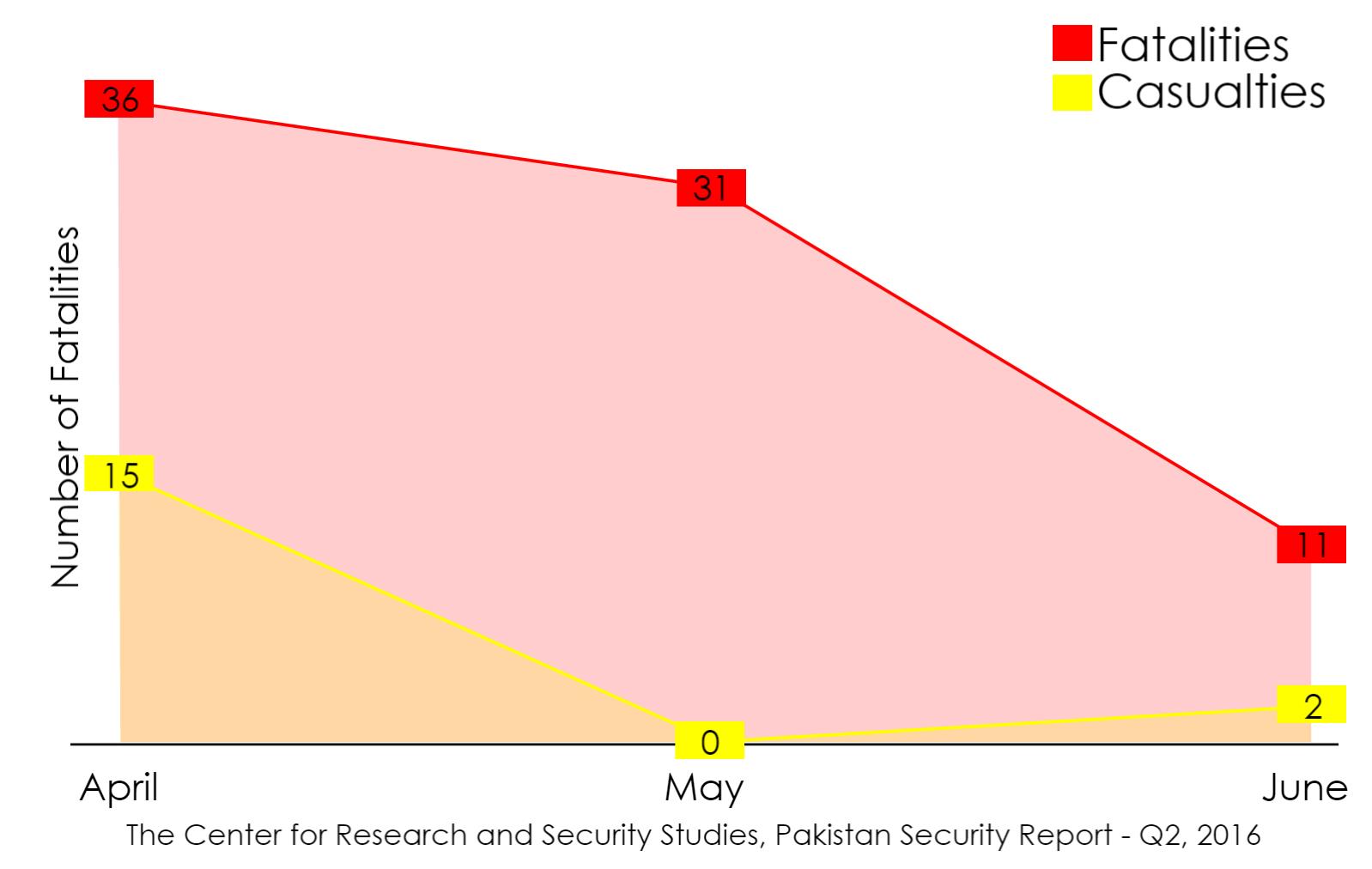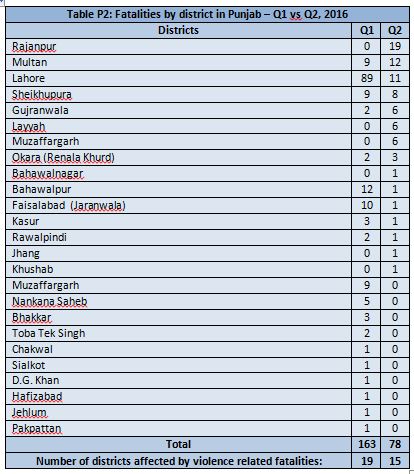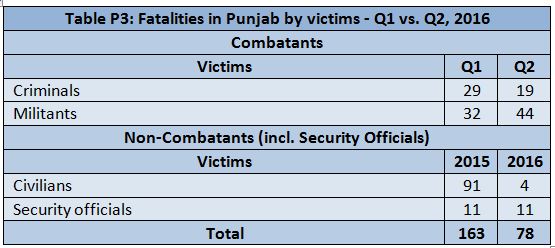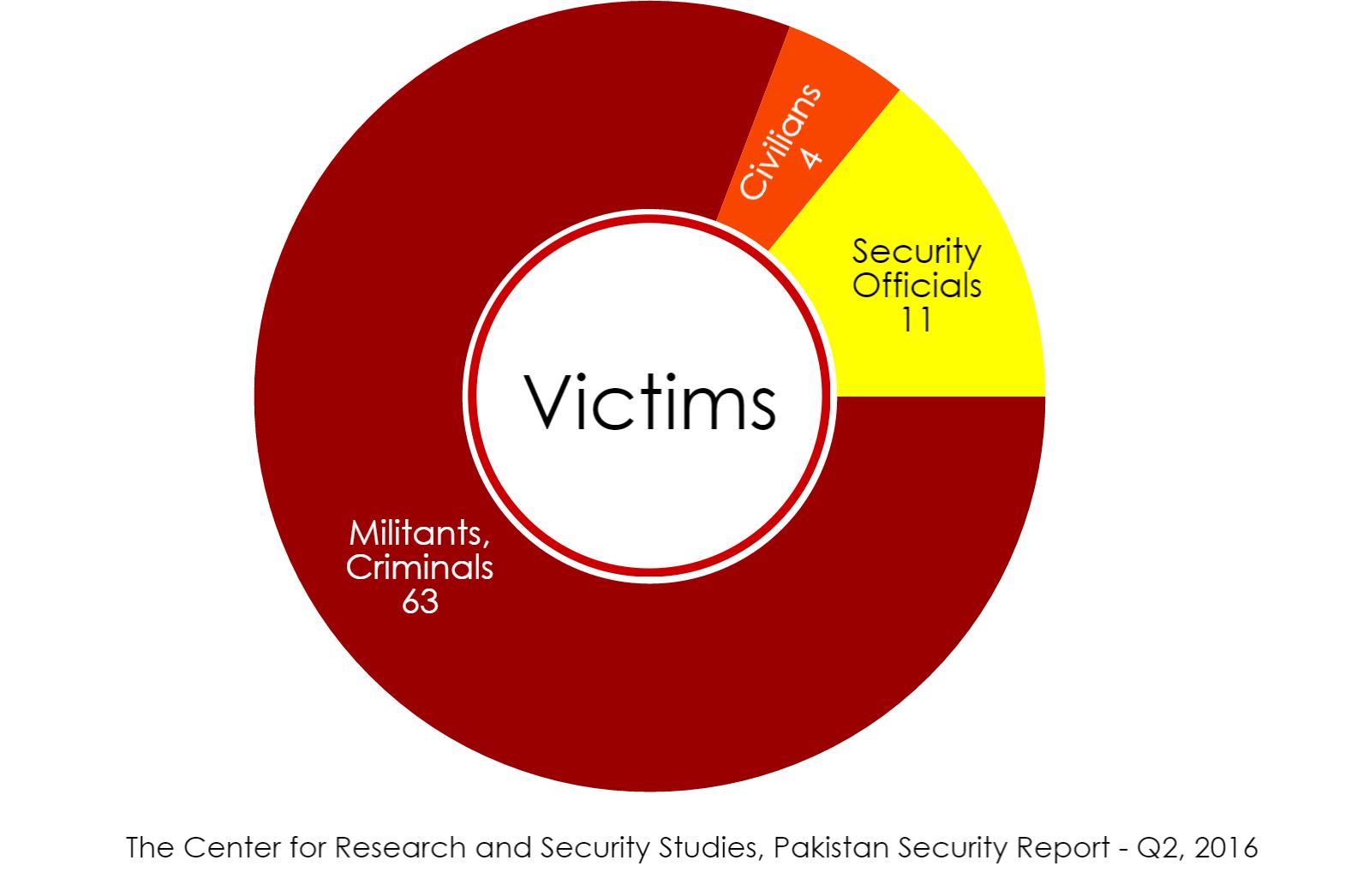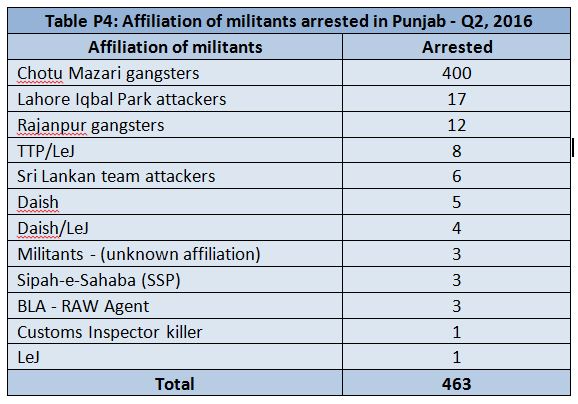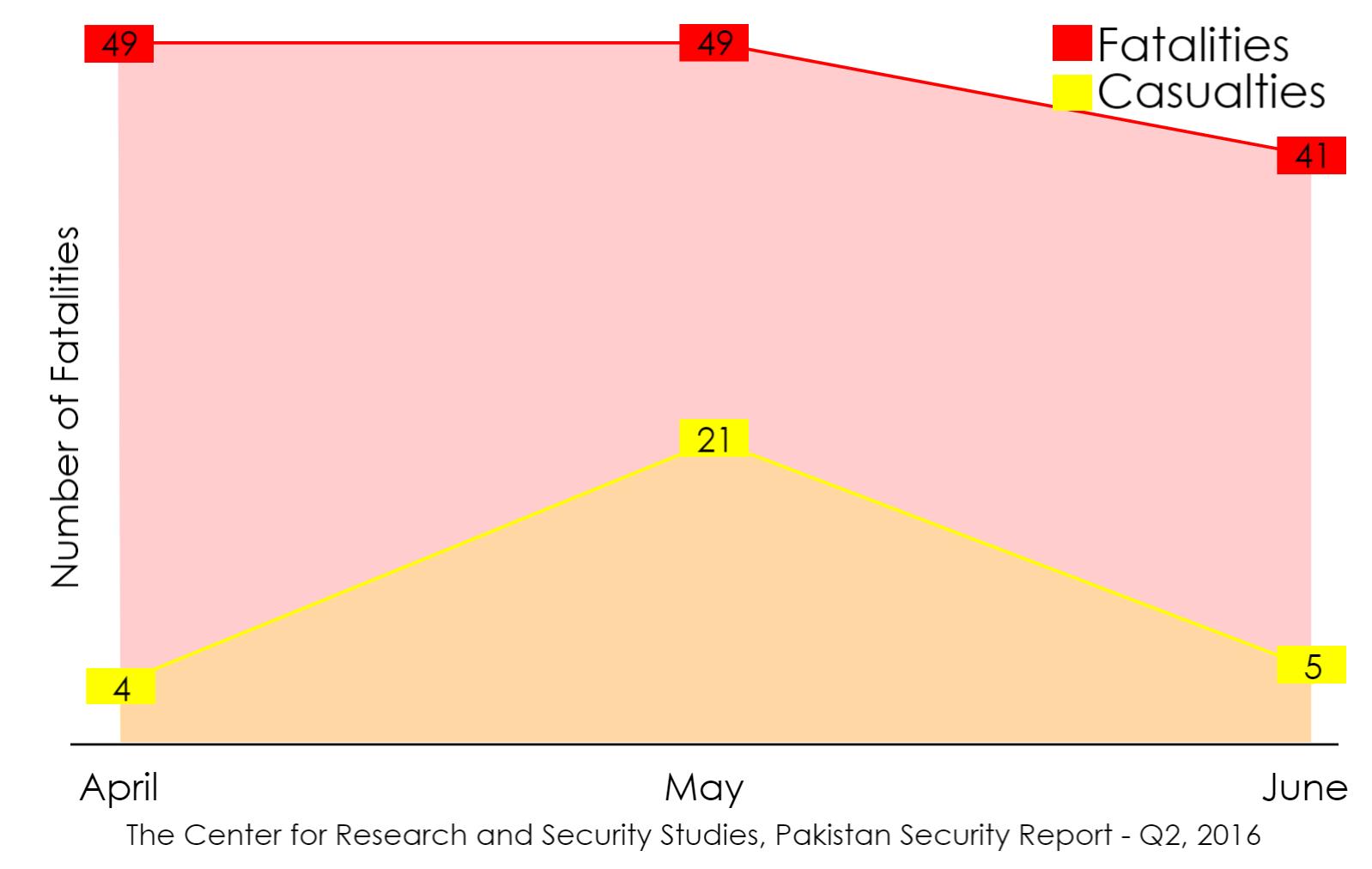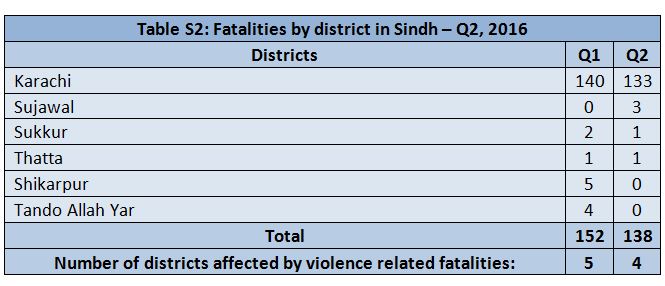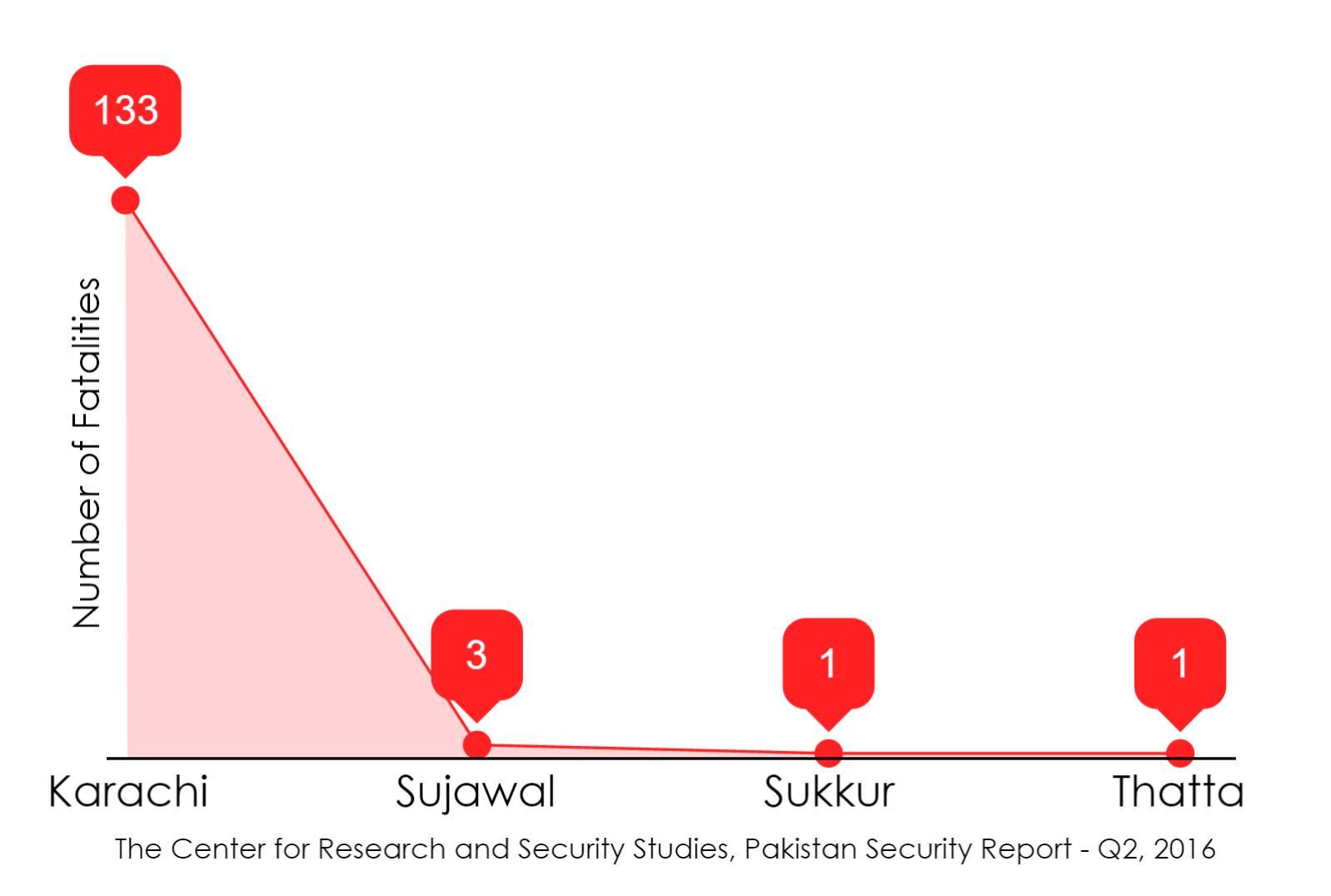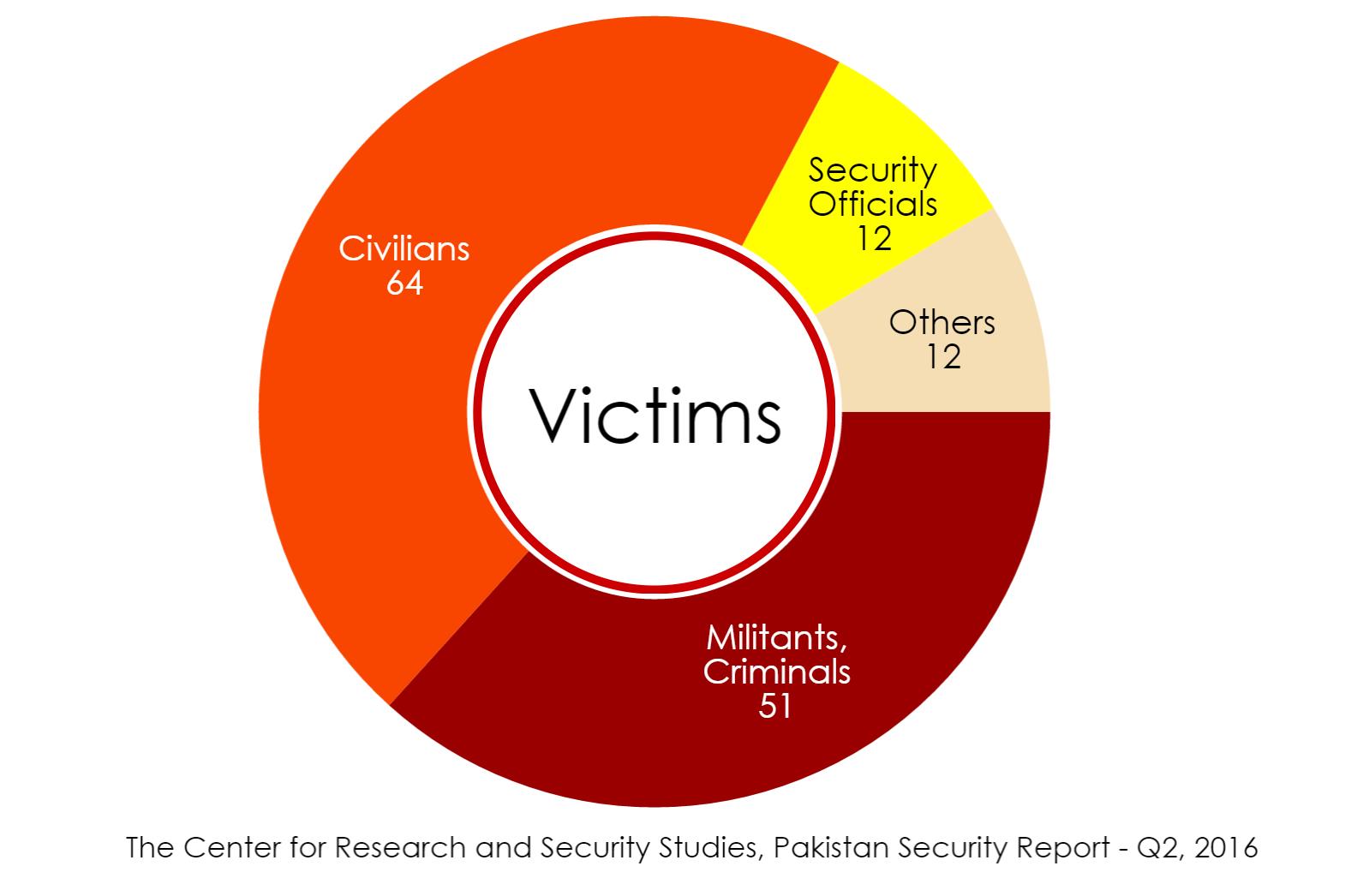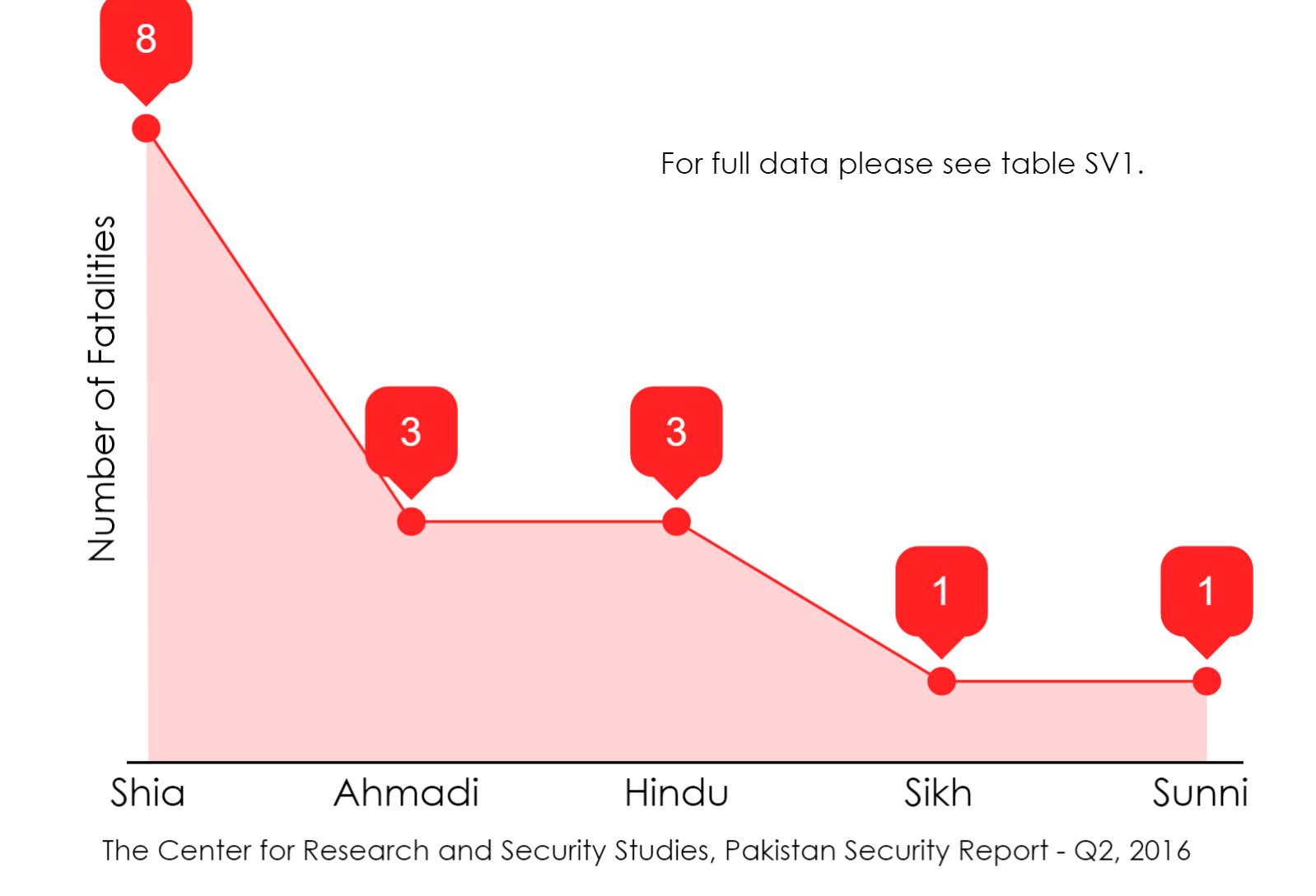Introduction
The upsurge in violence recorded during last quarter (January – March, 2016) dropped significantly during this reporting period (April – June, 2016). That being said, the militants, the noose ever-tightening around them, appear to have made a strategic shift in terms of areas of operation and targets. Chief of Army Staff General Raheel Sharif declared that the ongoing Operation Zarb-e-Azb was over, as the most dreaded areas in North Waziristan had been cleared. The military operation carried out in the riverine areas of the South Punjab also ended during this quarter with successful clearance of the area from the notorious gangster Chotu Mazari and his associates.
Other than these successes in the war on terror, a few high profile incidents of violence shocked the country. One of them was the brazen assassination of the popular Qawal, Amjad Sabri, during the holy month of Ramazan at one of the busiest locales in Karachi. This also caused concern about the presence of fully operations criminal elements in urban centers.
To assess and evaluate what new challenges and threats are being faced by the country, this report makes use of the national print and electronic media sources. CRSS endeavors to ensure that the data is as accurate as possible within the available resources. However, it does not rule out errors and omissions, which are always a possibility in such statistical works. Such mistakes, nevertheless, do not grossly affect the overall outcome and conclusions of this report.
Readers can approach CRSS for information related to this report. Alternately, you may send your queries to
mail@crss.pk, directly to Mohammad Nafees, Senior Research Fellow, CRSS – the author of the report (
mohammad.nafees@yahoo.com), or Zeeshan Salahuddin, Senior Research Fellow (
zeeshan@crss.pk) – the editor.
List of Acronyms
Security Report – Q2, 2016
Fatalities from Violence
There were 788 casualties of violence (545 dead and 243 injured) during the 2nd Quarter of 2016 (April-June, 2016). The FATA and Sindh regions, for the first time in last three years, recorded a lower number of fatalities than in Balochistan (table 01). Within this year, as many as 58 Pakistani militants, hiding in Afghanistan because of Operation Zarb-e-Azb, have been targeted by drone attacks. Coincidentally, Pakistani militants were not the only ones who were found and targeted in a foreign country. A high profile Afghan militant, Mullah Akhtar Mansur, Chief of Afghan Taliban, carrying Pakistani identification documents, was targeted by a drone strike while he was entering Pakistan from Iranian border in Balochistan.
Nearly 40% reduction in violence was observed throughout the country during the 2nd Quarter of 2016 (April – June 2016). The highest reduction in violence was noted in FATA as the military operation reached its logical conclusion. Punjab also had a significant reduction in violence (table 02).
269 militants and 270 non-combatants (including security officials) lost their lives during this (table 03). This is a significant drop from the previous quarter. Unfortunately, the largest group of victims of violence among the non-combatants were civilians (172), followed by security officials (72) and others. Out of 72 security officials who lost their lives in violence during this quarter, 46 were the policemen which is more than 60% of the total fatalities of security officials during this period. Seven of these policemen lost their lives while they were providing security to polio teams.
Militant attacks and target killings continued to show a significant reduction during this quarter (table 04). However, the victims of terrorism went up significantly during this quarter. Accidental explosions also killed 7 persons who were carrying explosives. The slowdown in security operations also brought down the number of fatalities. The incidents of robbery-related fatalities have also dropped significantly during this period (table 04).
Although the fatalities from encounters with LEAs dropped from 191 in last quarter to 155 during this quarter, these encounters still remained to be the highest causes of fatalities during this period. The highest decline was observed in suicide bombing incidents. Only 3 persons were the victims of suicide attack as against 125 fatalities counted last quarter. All other forms of violence also reflected a decline in the number of fatalities (Table 04).
A very few militant groups claimed responsibility of terror attacks that were carried out in the country (table 05). From the table below, it is evident that the militants groups either elected to make no claims or they are no longer in a position to carry out the type of violence that legitimizes them. Whatever the reason, the sharp decline in militants’ claim of violence is a good sign of an improved security situation in the country.
Balochistan
Compared to other provinces, the fatalities from violence in Balochistan witnessed a marginal drop during this quarter. From 181 fatalities last quarter, the figure came down to 166, a near 10% reduction (table B1). Among all provinces, the province of Balochistan had the highest number of fatalities from violence during this quarter (table 01). A US drone attack targeted Afghan Taliban’s leader, Mullah Akhtar Mansour, in a remote area close to the Iranian border. A month before his death, reports were appearing in the press that he was making preparation for launching a spring offensive in Afghanistan
. This incident, as claimed by Pakistan, derailed the initiatives for pursuing the Afghan militants to have a dialog with the Afghan government for restoration of peace in the region.
Kalat, Lasbella, Jaffarabad, and Panjgur experienced an upsurge in violence while places like Sibi, Kech, Quetta and Kohlu had either no occurrence of violence or a significant drop in it during this quarter. The number of districts affected by violence remained close to what was recorded last quarter (table B2).
The fatalities of militants and criminals were 50% of the total fatalities in Balochistan during this quarter, 5% increase over last quarter (table B3).
As many as nine Afghan spies were arrested from different parts of Balochistan during this quarter in addition to the three facilitators of Afghan Taliban. One was arrested on suspicion of having links with the Indian and Afghan Spy Agencies (table B4).
FATA
A total of 62 persons lost their lives in FATA during this quarter which is a significant drop in violence in the region (table F1).
Comparatively speaking, a 75% reduction in fatalities in FATA is observed during this quarter compared to previous quarter (table F2). Kurram and Mohmand Agencies were the two locations where the incidents of violence went up. During last three months, only one air raid by the Pakistan Air Force was carried out in the FATA region that targeted militants in the North Waziristan’s border area close to Afghanistan leaving 9 militants dead. Despite a significant slowdown of Operation Zarb-e-Azb, the militants could still manage to carry out armed attacks at different locations in the FATA region. In Khyber Agency, the majority of the victims of violence were members of the pro-government Peace Committees. The incidents of bomb, IED, and landmine explosions also took place in Mohmand, Khyber, and Kurram Agencies that left 10 persons dead and 13 injured.
The fatalities of militants were the highest in FATA when compared with the fatalities of civilians and security officials. However, a sharp decline in the number of fatalities of militants is visible during this quarter when compared against Q1 (table F3).
Khyber Pukhtunkhwa
As many as 198 persons (94 dead and 104 injured) were the victims of violence in the province of Khyber Pukhtunkhwa during the Q2, 2016. The highest number of casualties was recorded in May 2016 (table K1).

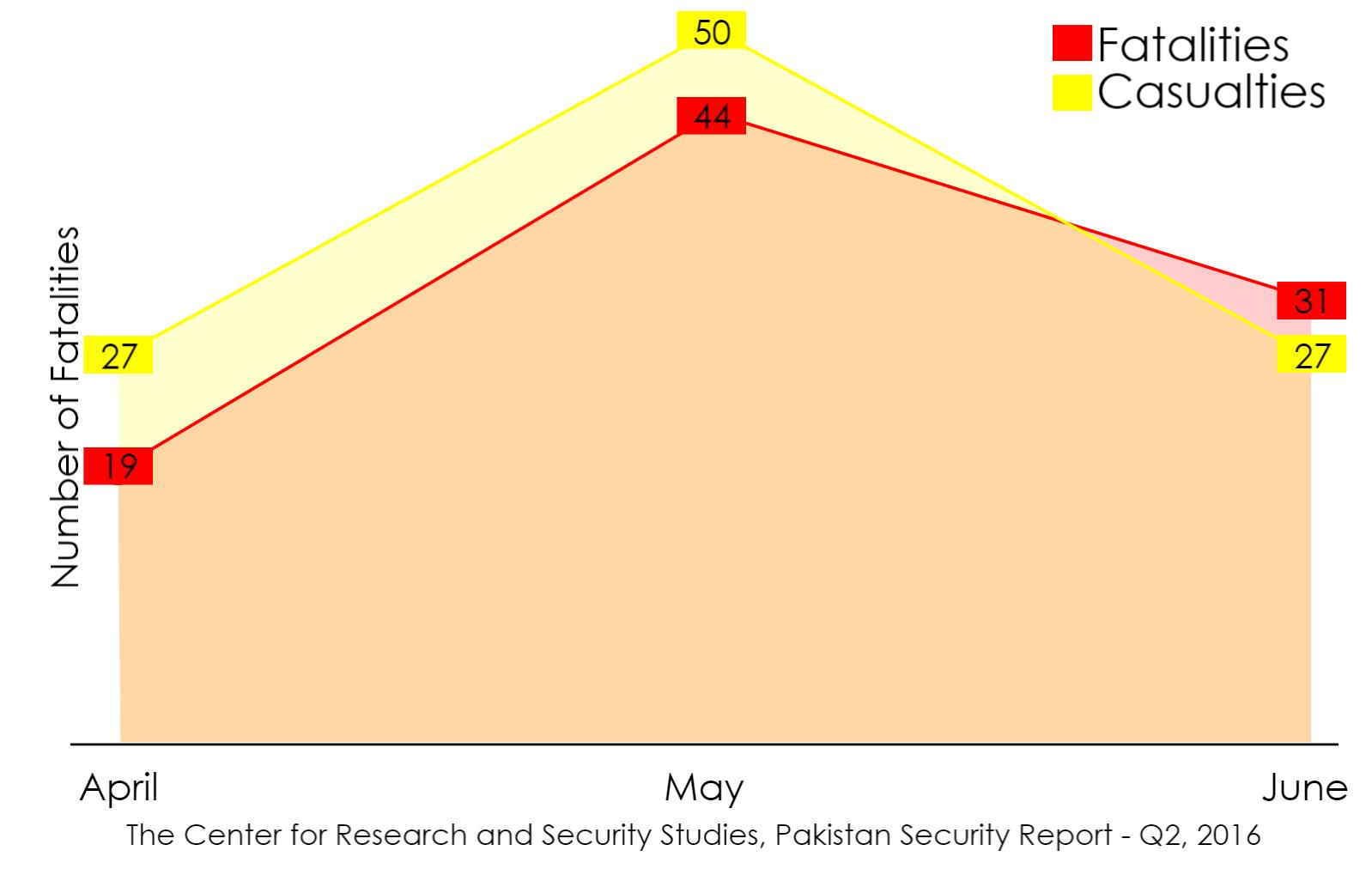
Compared to last quarter, fatalities from violence declined by 25%. However, civilians and security officials were close to 60% of the total fatalities in KP (table K2). The militants and criminals were a little over 30% of the total fatalities. For the last two years, the percentage of civilians and security officials has always been higher than the militants in Khyber Pukhtunkhwa.
Compared to last quarter, fatalities from violence declined by 25%. However, civilians and security officials were close to 60% of the total fatalities in KP (table K2). The militants and criminals were a little over 30% of the total fatalities. For the last two years, the percentage of civilians and security officials has always been higher than the militants in Khyber Pukhtunkhwa.
The data on the affiliation of the victims of violence bring to light the targets that were pursued by the militants and criminals. The police officials appear to be the main target of violence followed by political activists belonging to ANP and the pro-government Peace Committee members.
The districts of Peshawar and Charsadda witnessed a sharp decline in fatalities from violence while Swat and Lakki Marwat have suddenly emerged as the main targets of violence. Despite a drop in the number of fatalities, the number of districts affected of violence went up during this quarter (table K3).
Punjab
In Punjab, 78 persons lost their lives to violence during this quarter while the number of persons injured was 17. The mount and scope of violence dropped significantly in this quarter (table P1).
More than a 50% drop in violence was recorded in Punjab during this quarter, when compared against Q1, 2016. As many as 35 victims of violence in Rajanpur, Layyah, Multan, Muzaffargarh, Bahawalnagar, and Bahawalpur districts of South Punjab were militants and criminals. During a security operation in the Katcha area of Rajanpur, 10 policemen were also targeted by Chotu Mazari gang.
Among the victims of violenceinthe Punjab, the highest percentage was of militants and criminals (80%). Based on these figures, the security situation in the province appears to be highly satisfactory and well within the control of security agencies.
Despite a law and order situation appearing so good, concerns are expressed from different quarters that the province of the Punjab is a safe haven for the 70 banned outfits and no action is being taken against them by the local government. Although local government denies these allegations, the two major security operations that were carried out in Rajanpur against the Chotu Mazari gang during this quarter indicate that there is a need for the Punjab government to take some house cleaning initiatives. A large number of militants, gangsters, and other criminals arrested in the province during this quarter also reflect the presence of such elements in the province based on their affiliations (Table xxx).
Sindh
For two consecutive quarters, Sindh has recorded violence related fatalities lower than Balochistan (table 01 and 02). As many as 139 persons lost their lives and 30 were injured during this quarter (table S1). The fatalities of 139 in three months is close to what this province recorded in one month during previous years.
The number of fatalities in Sindh during this quarter was lower than previous quarters. A similar reduction is noticeable in Karachi as well (table S2). For the last three years, Karachi has been known for frequent target killings and other crimes, and the average number of fatalities per month during last year was around 100 persons. During 6 months of this year, this average has come down to 48 persons per month – more than a 50% reduction in violence in Karachi. A significant reduction in violence is also observed in other districts of the province as well.
Fatalities of non-combatants (civilians and political activists), including the security personnel, was 65% of the total fatalities. After KP, Sindh was the only province where civilians and security officials had higher number of fatalities than the militants and criminals. Out of 64 fatalities of civilians in Sindh, 51 were the victims of target killing in Karachi alone (table S3).
Among the militants and criminals that were arrested in Sindh during this quarter, a sizeable number of them were suspected to have association with Indian Spy Agency – RAW. The militants belonging to banned outfits like Lashkar-e-Jhangvi (LeJ), Tehreek-e-Taliban Pakistan (TTP), AQIS (Al-Qaeda in the Indian Sub-continent), and many others were also arrested as suspects for the terror and target killing activities that had occurred in the past (Table xxx).
AJK, GB, and Islamabad
No incident of violence reported from AJK, GB, and Islamabad during this quarter.
Sectarian Violence
The only provinces that experienced sectarian violence during this quarter were KP and Sindh (table SV1). Last quarter 79 people lost their lives to sectarian violence, compared to 16 this quarter. This is a nearly 80% reduction.
Conclusion
The overall security situation has improved noticeably in the country with all provinces showing various level of reduction in the number fatalities from violence.
Although the military operation is nearing conclusion, the operation in Karachi continues and may be further extended because of high profile incidents of violence in the city. Karachi, a city-state of an estimated 24 million people, will continue to be a massive security challenge for Pakistan.
The security threats posed by the dacoits having sanctuaries in Katcha areas of the South Punjab has also been removed after a successful army operation in the area.
Many districts of Balochistan and KP became frequent target of militancy. Among security personnel, policemen were primarily targeted by militants. A good number of these policemen were on the security detail for the polio vaccination teams.
Sectarian violence also witnessed a sharp drop during this quarter. From 79 fatalities from sectarian violence in the country during last quarter, the number came down 16 during this quarter, a nearly 80% reduction.
While on the surface, the situation seems to be improving, it must be said that progress on several point in the National Action Plan remains abysmal at best. Pakistan has gotten increasingly proficient at physical destruction of militant hideouts, weapon caches and arresting/killing the criminal element, but the ideology that fuels it continues to create divides. Unless this ideology is targeted through a focused approach and propelled by political will, this temporary relief may be short-lived.
http://www.thenews.com.pk/print/111659-Taliban-chief-consolidating-power-for-spring-battle

